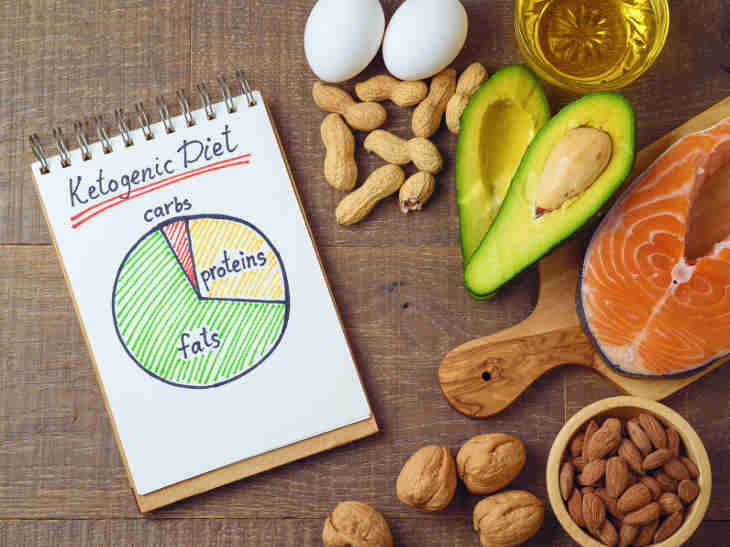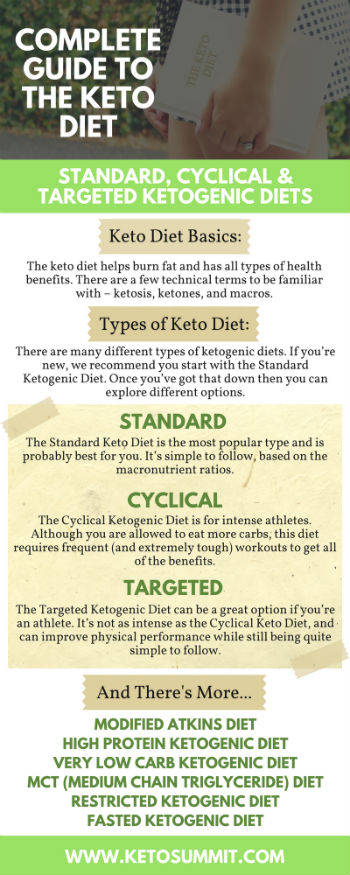Complete Guide To The Standard, Cyclical, and Targeted Ketogenic Diets
Just when you think you’ve got to grips with keto, you realize:
There’s more than one type of keto diet – Standard, Cyclical, Targeted, Modified Atkins and more…
What are the differences between them? What are the pros and cons? And which type of keto diet should you be on?
This article will explain the different types of keto diets and will guide you to which one is best for your lifestyle and goals.

A quick recap of Keto
What’s a Keto Diet?
The short answer is, it’s a diet which puts your body into a fat burning metabolic mode called ketosis – which has all sorts of health benefits.
Normally our bodies are burning glucose for fuel, and that’s why our energy spikes and dips, we crave sweets in the afternoon and we get grumpy when we haven’t eaten.
When we switch to burning fat for fuel, we become more alert, our minds are clearer and our energy levels stabilize. Great, right?
3 Common Technical Terms for Keto Dieters
- Nutritional ketosis is when your body goes into ketosis because of changes you make to your diet. By cutting down the amount of carbohydrates we eat, our bodies are forced to stop relying on sugar as an energy source and start burning fat instead.
- Ketones (or ketone bodies) are produced by the body when fat is broken down during ketosis. And these ketones act as an energy source for certain cells in your body (including your brain cells). One way to check whether you’re in ketosis or not is by measuring your ketone levels.
- Macronutrient ratios (or macros) are the ratios of carbs/protein/fat you consume on the keto diet – low-carb/moderate protein/high fat. The exact ratios will vary depending on which type of keto diet you choose.

Bottom Line:
The keto diet helps burn fat and has all types of health benefits. There are a few technical terms to be familiar with – ketosis, ketones, and macros.
So now that we’ve got all the basics covered…
…What are the differences between all those different types of keto diets?
What is the Standard Ketogenic Diet (SKD)?
First up is the most popular kind of ketogenic diet: the Standard Ketogenic Diet – and for the majority of people who are looking to go keto, this is the diet they need.
When you hear someone mentioning the keto diet, this is usually the one they’re talking about. And in studies, they might refer to this as the Very Low Carb Keto Diet (VLCKD).
What are the macronutrient ratios for the Standard Keto Diet?
- You split your daily calorie intake so that it’s 5% carbs, 20% proteins, and 75% fats
- Our online calculator will help you determine exactly how much to eat, both in calories and in grams of carbs, protein, and fat.
- For most folks, that means limiting carbohydrates to under 25g per day.
Does it matter when I eat my carbs on the Standard Keto Diet?
- Nope! That’s totally up to you – as long as you stick to the daily limit, you’re free to eat your carbs whenever you like.
What are the pros of the Standard Keto Diet?
- We’ve just mentioned a big one: you get to choose when/how you consume your carbs. You can save them all for one meal, or spread them throughout your day, whatever your prefer!
- Plus, it’s simple to follow – you just focus on hitting your macros each day.
If you’re looking for more in-depth info on the Standard Ketogenic Diet, check out our Ultimate Guide to the Ketogenic Diet.

Bottom Line:
The Standard Keto Diet is the most popular type and is probably best for you. It’s simple to follow, based on the macronutrient ratios.
While we love the SKD and think it’s the best place to start with Keto, there are some reasons to incorporate more carbs into your diet. Dr. Peter Attia, M.D. says that when it comes to carbohydrates, it’s really not a one-size-fits-all. “The key is knowing how much you need and when to take them.”
What is the Cyclical Ketogenic Diet?
The Cyclical Keto Diet is designed for serious athletes: we’re talking bodybuilders and other professionals. It’s definitely not recommended for beginners.
According to Health and Fitness Coach Jeff Popoff, “A cyclic ketogenic diet (or carb-cycling) is a low-carbohydrate diet with intermittent periods of high or moderate carbohydrate consumption. This is a form of the standard Ketogenic diet (SKD) used as a way to maximize fat loss while maintaining the ability to perform high-intensity exercise.”
It’s the Standard Keto Diet optimized to maximize muscle growth by adding in periods of carb loading.
What does the Cyclical Keto Diet involve?
- Sticking to a Standard Keto Diet (under 25g of carbs) for 5-6 consecutive days
- Then enjoy a 1-2 day carb loading period where carb intake jumps to 60-70% of daily calorie intake
How does the Cyclical Keto Diet help athletes?
- During the low-carb days, the body is forced to burn fat – giving athletes a leaner body composition.
- On the high-carb days the muscles fill up their stores of glycogen (an energy storage molecule your body makes from glucose) – and having plenty of stored glycogen can improve performance in the gym.
- But athletes have to use up all their glycogen between carb loading periods or they won’t get the fat loss benefits.
Why isn’t the Cyclical Keto Diet suitable for everyone?
- Folks who start the Standard Keto Diet are often aiming for weight loss or to clear up health problems. The Cyclical Ketogenic Diet has a different focus.
- It involves some seriously tough workouts between carb loads – only serious athletes can put in the intense training required to empty the muscles of glycogen.
This diet can be too tough even for seasoned athletes!

Bottom Line:
The Cyclical Ketogenic Diet is for intense athletes. Although you are allowed to eat more carbs, this diet requires frequent (and extremely tough) workouts to get all of the benefits.
And that’s why the Targeted Ketogenic Diet is also a good option… more info coming up in the next section.
What is the Targeted Ketogenic Diet (TKD)?
This is another one for the athletes (but don’t worry, we’ll be covering more variations for non-athletes in the next section).
The Targeted Ketogenic Diet (TKD) is similar to the Standard Ketogenic Diet. However, on workout days, you consume your carbs before or around your workout session.
What does the macro consumption look like on the Targeted Ketogenic Diet?
Before a workout:
- Most folks who follow this diet eat between 5 and 15g of carbs around 20-30 minutes before they work out.
- They stick to high-glycemic carbs that are easy to digest and provide quick energy.
- They avoid fructose, which is stored as glycogen in the liver rather than the muscles.
After a workout:
- High-fat foods are avoided for 1-2 hours after training. Dietary fat can slow digestion, which delays nutrient delivery during the muscle recovery period.
- Consuming protein can help with muscle building and repair.
On non-workout days, dieters follow a Standard Keto Diet.
How does a Targeted Ketogenic Diet affect the body?
- It helps athletes keep their muscle glycogen at a steady level for peak performance during workouts.
- Consuming carbs just before exercise means the body burns up the carbs during the workout – so there’s just a temporary interruption of ketosis.
- That means you get all the usual benefits of ketosis when you’re not exercising.
Who is the Targeted Ketogenic Diet good for?
- Athletes who find a Cyclical Ketogenic Diet unsuitable. The periods of carb loading can play havoc with the blood sugar levels of sensitive individuals.
- Athletes who have an exercise program that’s intense, but not intense enough to make a Cyclical Keto Diet beneficial.

Bottom Line:
The Targeted Ketogenic Diet can be a great option if you’re an athlete. It’s not as intense as the Cyclical Keto Diet, and can improve physical performance while still being quite simple to follow.
Are the Cyclical and Targeted Ketogenic Diets good for non-athletes?
According to Sports Nutritionist Rudy Mawer, CISSN, “Cyclical or targeted ketogenic diets are more advanced methods and primarily used by bodybuilders or athletes.”
The Cyclical and Targeted Ketogenic Diets were designed specifically to help serious athletes improve their performance and push their limits. There’s no need for you to periodically load up on carbs if you’re not doing some seriously intense exercise.
If you’re not an athlete, the Cyclical and Targeted Ketogenic Diets aren’t for you.
It’s still a good thing to exercise on the keto diet though – especially if you’re aiming to make your lifestyle healthier. Yoga, jogging, bike rides…these are all great sports to incorporate.
Bottom Line:
If you’re not an athlete, then don’t use the Targeted or Cyclical Ketogenic Diet.
But don’t worry, there are other keto diet variations you can try too!
What are the other types of ketogenic diet?
There are other types of ketogenic diet which aren’t geared specifically towards athletes.
- Modified Atkins Diet is a higher protein version of the Standard Keto Diet, and the macro ratios are 10% carbs, 30% protein and 60% fat. This may be easier to stick to while still effectively putting your body into ketosis.
- High Protein Ketogenic Diet is also similar to the Modified Atkins Diet but with even more protein: the macros are 5% carbs, 35% protein and 60% fat. It’s best for anyone who lifts weights 4 – 6 times per week and is concerned about maintaining muscle mass.
- MCT (Medium Chain Triglyceride) Diet is used as a dietary therapy to treat epilepsy in children and includes MCT oil as a supplement or a component of most meals. Because MCT oil is great at putting your body in ketosis, kids on an MCT diet are able to eat more carbs/protein than on a Standard Keto Diet.
- Restricted Ketogenic Diet is mainly prescribed and carried out under medical supervision for patients who suffer from epilepsy. It is also being trialed for other disorders like cancer and Alzheimer’s Disease.
- Fasted Ketogenic Diet combines two great diets – intermittent fasting and the keto diet. You stick to the macro ratios of a Standard Keto Diet and adapt meal times to fit an intermittent fasting schedule.

Bottom Line:
There are many different types of ketogenic diets. If you’re new, we recommend you start with the Standard Ketogenic Diet. Once you’ve got that down then you can explore different options.
If you feel ready to start the Keto diet…
We recommend getting started on the Standard Keto Diet. We want to make this process as easy as possible for you because we’ve personally struggled with it. So we put hundreds of hours into designing some great meal plans and tips for getting started to make things easier for you.
Pinterest Image For Complete Guide To The Standard, Cyclical, and Targeted Ketogenic Diets
Please pin the image below so that you and others can quickly and easily refer to the list and learn about all of the different types of Keto diet!

